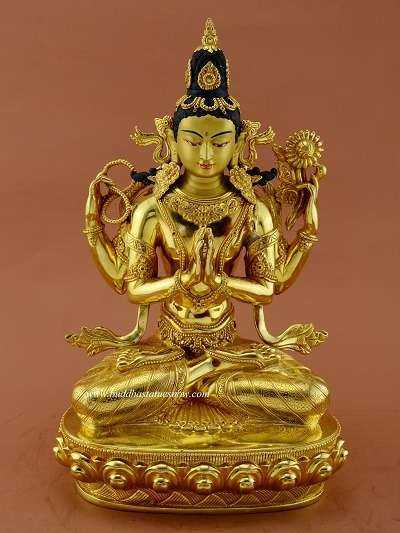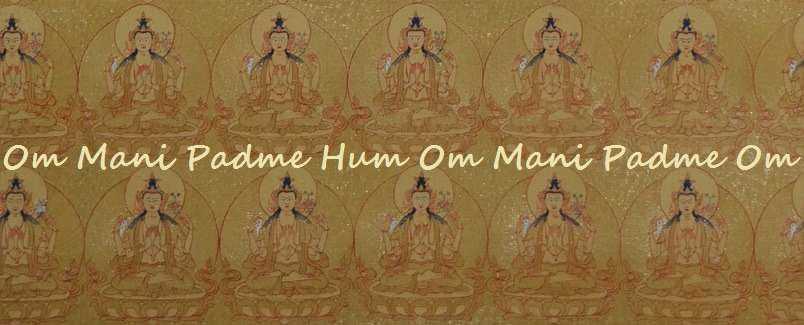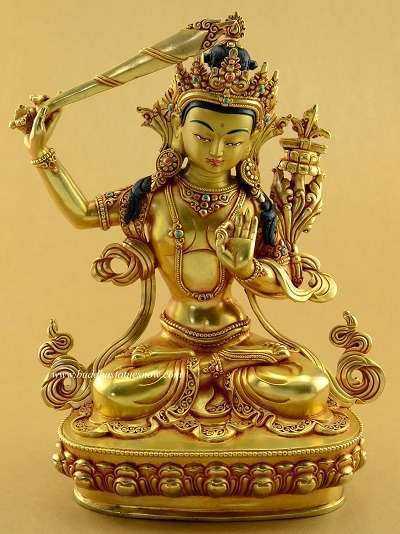The use of Buddhist mantras is the most beneficial method for mantra meditation practice. Fortunately, these benefits are accessible for everyone, not just the Buddhas. Additionally, devotees can learn to practice the most effective mantra meditation in minimal time. You can also practice in the comfort of your own home.
The benefits of mantra meditation are immediate and they also have tremendous potential. Learn everything here, including the three most powerful Buddhist mantras for mantra meditation.
The Basics of Mantra Meditation
Lets get the technicalities out of the way first. To begin, the mantra meditation definition is based on the Sanskrit word mantras which is literally “tools of the mind”.
Indeed, inducing sustained concentration has many benefits that are also physical and not only mental. As a result, Buddhist mantra chanting is becoming increasingly appreciated by modern medicine as a form of both physical and mental healing.
The Origins of Mantra Meditation
It is important to note that mantra meditation is really a form of Samatha meditation (a.k.a. tranquility meditation). This is because mantra meditation uses the Buddhist mantra as a single point of concentration, in contrast with the multi point focus of Vipassana meditation.
Traditionally, the single concentration point used in Samatha meditation is one of the four foundations of mindfulness such as the body (kaya), feelings (vedana), mental states/consciousness (citta) or mind objects (dhamma). In comparison with traditional methods, mantra meditation techniques focus on the harmony and precise rhythm of repeating the Buddhist mantra over and over. But why is this?
This is because the physical body allows meditation practitioners to effectively access concentration points with the least amount of effort. Certainly, some points of concentration are easier to use than others and the rhythmic harmony of natural breathing is most effective.
Therefore, for both beginners and advanced meditation practitioners, a focus point such as a Buddhist mantra is a very useful meditation tool. As a result, mantra meditation practitioners can rapidly induce concentration and quickly realize the benefits.
Why is Mantra Meditation Beneficial?
The same rhythmic harmony of natural breathing is also evident in Buddhist mantras. Indeed, the Buddhist mantras produce melodic vibrations which are ideal for inducing sublime forms of consciousness known as the jhanas.
The jhanas block out the hindrances to spiritual realization which the Buddha identified as sensual desire, ill will, sloth/torpor, restlessness/worry and doubt. As a result, inducement of jhana concentration is essentially a temporary state of Nirvana.
Furthermore, using Buddhist mantras can produce benefits beyond concentration. Indeed, mantra meditation benefits include curing disease, eternal youth, developing wisdom and they can even absolve sin. This is a fascinating subject with a history that spans thousands of years.
3 Easy To Learn Buddhist Mantras
Although certain Buddhist mantras can have as many as 100 syllables, there are also many short mantras to choose from. As a result, short and easy to learn Tibetan Buddhist mantras can be most effective for mantra meditation.
Affiliation of the mantra with a patron deity is very important because it strengthens the effects of recitation. The source of the best Buddhist mantras is from Buddhas and high level Bodhisattvas. If the devotee has sufficient faith in the patron deity, they will benefit from the sublime virtues associated with the Buddha or Bodhisattva.
Here are three of the most popular, easy to learn mantra meditation examples using the three most effective Buddhist mantras.
Avalokiteshvara’s Mantra for Total Purification
One of the most powerful Buddhist mantras belongs to a most venerable and high level Bodhisattva known as Avalokiteshvara. The virtue of compassion is integral to the Buddhist teachings. Indeed, it is the joining of compassion and wisdom which enables devotees to obtain enlightenment. As a result, Avalokiteshvara has become known as the embodiment of compassion. Additionally, Avalokiteshvara represents the compassion of the Buddhas.
This strong association with compassion is because Avalokiteshvara has vowed to indefinitely forgo enlightenment until the suffering of all sentient life ceases. However, this is an immense undertaking which will go on indefinitely without a sufficient cure. The mantra of Avalokiteshvara is an important method to help him fulfill his vow.
The Avalokiteshvara mantra was intricately designed to assist each sentient in purifying their body, speech and mind. As a result of their purification they will become Buddhas (the end suffering).
Bodhisattva of Compassion

Avalokiteshvara Mantra:
“Om Mani Padme Hum”
His holiness the 14th Dalai Lama, emphasizes the teachings of the future Buddha – Maitreya – “All beings naturally have the Buddha nature in their own continuum”. As a result, with the help of the Avalokiteshvara mantra, devotees can realize the Buddha nature for themselves. Additionally, Tibetan Buddhists believe that the Dalai Lama is an incarnation of Avalokiteshvara. Therefore, his insights into meaning of the Avalokiteshvara mantra are very significant.
Amitabha Buddha’s Pure Land Buddhist Mantra
Over thousands of years, Amitabha Buddha has become very closely associated with Avalokiteshvara. Indeed, they have evolved together to become central figures in the Mahayana Buddhist teachings. Additionally, Amitabha Buddha is the central figure of Pure Land Buddhism.
Amitabha is a Sanskrit word that translates as “Infinite Light” in English. Also, Amitabha Buddha was once a high level Bodhisattva known as Dharmakara who vowed to forgo Buddhahood until he had obtained his own pure land.
However, it would take countless Bodhisattva lifetimes before he would accumulate enough merit to accomplish his goal. As a result, he finally obtained his own pure land and he has become known as the “Buddha of Infinite Light”.
Amitabha Buddha’s pure land is called “Sukhavati” and it the most sought after paradise in Pure Land Buddhism. The key to entering his pure land is the recitation of the Amitabha Buddhist mantra. Additionally, entrance to Amitabha’s land of visual and sonorous bliss only requires devotees to recite his mantra a minimum of 10 times.
Amitabha Buddha
Amitabha Buddha Mantra:
“Om Amitabha Hrih”
Once admitted to Sukhavati devotees will be nurtured and protected until they are able to become Buddhas. Additionally, under the protection of Amitabha Buddha they will never fall back into the vicissitudes of samsara.
Manjushri’s Buddhist Mantra to Purify Wisdom
The state of enlightenment is the eternal combination of the attributes of compassion and wisdom. Avalokiteshvara is the embodiment representing the attribute of compassion and Manjushri is the embodiment of wisdom. Therefore, the focus of the Manjushri mantra is to help develop insight wisdom. However, in order to develop insight wisdom, devotees must realize the true nature of phenomenon and the laws of conditionality (karma).
Although the Manjushri mantra targets the development of insight wisdom, it will also develop ordinary wisdom. As a result, the Manjushri mantra is commonly used by students and intellectuals who wish to enhance memory, speech and writing skills.
Furthermore, acquiring new wisdom can induce longevity. Therefore, statues of Manjushri often depict him with youthful looks. Indeed, the Bodhisattva of wisdom is also known as “Prince Manjushri”.
The Bodhisattva of Wisdom
Manjushri Mantra:
“Om A Ra Pa Tsa Na Drih”
Ultimately, developing our minds with mantra meditation will enable us to interject wisdom into our daily actions. As a result, we will be better equipped to assist other sentient life at the right place and time.
Furthermore, Manjushri resides in his earthly abode (bodhimanda) and it is located in NE China on top of a high mountain range known as “Wutai Shan”. Additionally, Manjushri has his own pure land known as Vimala. It is an Eastern paradise that will one day rival Amitabha’s Sukhavati.
How Do You Practice Mantra Meditation?
Fortunately, mantra meditation practice is very flexible and easy to learn. To begin your practice, find a quiet location inside your home. As a result, this would be a secluded room with sufficient privacy that is also exclusive of distractions. However, if this option is not available then visit your local Buddhist meditation center.
When your are ready to begin, simply sit cross legged on the ground with your back straight. Also, lay your right hand flat on top of the palm of your left hand with your thumb tips lightly touching. Additionally, the next step is to close your eyes with your hands in your lap. It is that simple! Therefore, you are ready to begin reciting the Buddhist mantra you chose for practicing mantra meditation.
108 Mala Beads for Mantra Meditation
It is more efficient if you have an efficient way of keeping count of the mantra recitations you have completed. Therefore, using 108 mala beads will keep track of the completed mantras for you. As a result, you can focus 100% on each mantra recitation. Additionally, for beginners, aim for forty correct recitations per sitting. As you progress, you can aim for a total of 108 recitations which is the amount a Buddhist monk would do.
Also, there is no such thing as saying too many or too few mantras. You can repeat the mantra fast or slow according to your own rhythm. Additionally, do not worry too much about the correct pronunciation at first. What is most important is that you sustain concentration for as long as possible. As a result, you will experience the world of enlightened beings.
Furthermore, it is not necessary to say the mantras out loud because silent mantra meditation can be just as effective. Therefore, you can practice mantra meditation anywhere, anytime.



